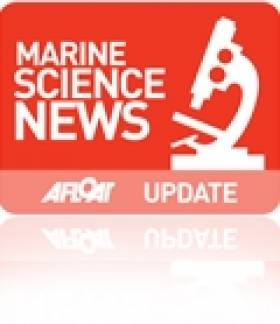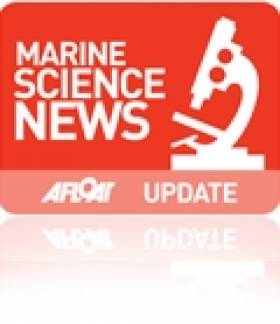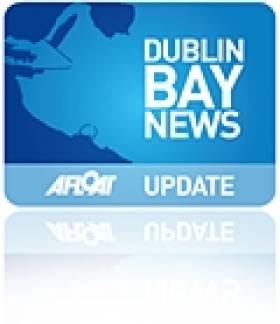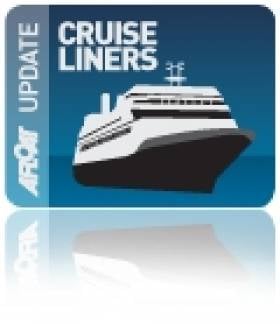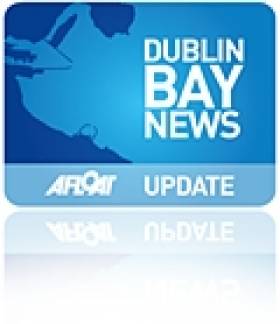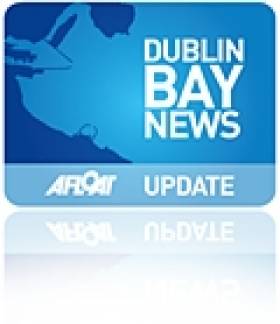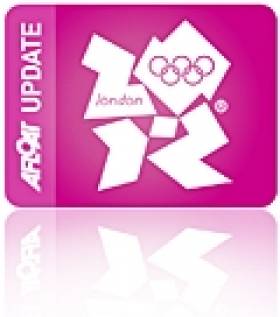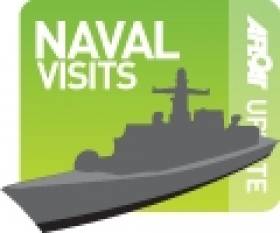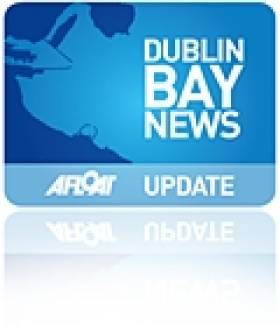Displaying items by tag: Dublin Bay News
According to the vessels survey schedules, RV Celtic Explorer had today completed fisheries demersal surveys which started in Galway on 23 September. The near fortnight-long survey was conducted in the ICES area VI, under the direction of chief scientist, Dave Stokes.
On Friday she embarks on a herring acoustic survey which is to take place in the Celtic Sea and the south-west. This survey will be under chief scientist Ciaran O'Donnell and is to de-mobilise in Cork on 27 October. To read more about her 2011 survey programme click HERE.
Across Dublin Bay in neighbouring Dun Laoghaire, the 31m RV Celtic Voyager is currently nearing the end of a month-long hydrography survey of the Celtic Sea. The survey had started in Howth Harbour on 17 September under chief scientist Kevin Sheehan. For the time-being she remains moored in Dun Laoghaire prior to resuming survey work which will continue until the vessel de-mobilises in Rosslare in mid-October. To find out more about her remaining surveys for this year click HERE.
On the surveys outlined they are conducted on behalf of Marine Institute scientists, though the vessels are also allocated ship-time for use of third parties. These include government departments and agencies, universities, research institutes and industry. For further information on the research vessels, survey schedules etc can be found by visiting: www.marine.ie/home/Research+Vessels.htm
Research Vessel on Hydrographic Survey Calls to Dun Laoghaire
RV Celtic Voyager is an inshore RV and she can accommodate 6 - 8 scientists with a maximum endurance of 14 days. According to her intensive survey schedule she is currently conducting hydography work for this month entirely. To read her complete survey programme click HERE.
In 2002 she was joined by a second though considerably larger vessel the 65m RV Celtic Explorer, which is six times larger than her fleetmate in terms of tonnage, which is 2,425grt. Apart from all the scientific and deck machinery she can also handle seven 20-foot containerised laboratories.She has accommodates for 35 personnel, including 19-21 scientists and has an endurance window of 30 days.
The vessel was also built by the same Dutch shipyard and both are owned by the Marine Institute. Ship management of the Galway based pair is provided by P&O Maritime Services (Ireland) Ltd.
In addition the ROV Holland I a deepwater Remotely Operated Vehicle is operated on board the RV Celtic Explorer. The ROV is named after John Phillip Holland from Liscannor, Co. Clare who was an early inventor and builder of submarines. For more information about the ROV which forms as part of tonight's 'Sea2Sky' event in Salthill, Galway, as previously reported on Afloat.ie click HERE.
Today is European Researchers Night, where the ROV will be on display in Galway
- Marine Institute
- Dublin Bay News
- Ports and Shipping
- Ports and Shipping News
- ROV Holland I
- Dun Laoghaire News
- Marine Science News
- Dun Laoghaire Harbour News
- Marine Instistute Research vessels
- Damen B.V. Shipyard
- P&O Maritime Services Ltd
- Submarine inventor John Philip Holland
- John Holland
- Irish research vessels
Courtown Harbour Rowing Club took second place in a time of 3:3:19 and third place honours went to Stella Maris Rowing Club with a time of 3:16.00. The hosts of the Hobblers Challenge, St. Michaels Rowing Club based out of the Coal Harbour, passed under the high walls of the East Pier Lighthouse and battery some two minutes later in fourth place.
The annual event (for race-route click HERE) was only re-introduced onto the race calendar last year after a break of several years. The skiffs were launched at the Coal Harbour slipway where they headed over to line-up for the starter's gun opposite the Hobbler's Memorial located on the publicly accessible Eastern Breakwater which is between the Stena Line HSS fast-ferry berth and the Dun Laoghaire Marina.
In attendance to greet the start of the race in memorial of the Dublin Bay hobblers was the RNLB Anna Livia of the local RNLI lifeboat station. The bronze memorial depicts a tower of lifejackets in commemoration of three young Dun Laoghaire hobblers who after piloting and unloading the schooner Jealous of Me in Ringsend, failed to return home.
This occupation was carried out by men also from Ringsend, Dalkey and other harbours and it was the first crew to reach a ship and throw a hook on the deck who would win the business of pilotage and unloading in Dublin Port.
Crews would think nothing of rowing out to the Kish Bank on the hope of spotting a ship. If they waited offshore and no passing trade appeared along the East Coast the craft doubled as a bed if it became too late to row home. The craft were much larger and heavier compared to the present day skiff and it is in these oarstrokes that the Hobblers Challenge follows the original race of the hobblers during the 18th and 19th centuries.
It was apt that on the same day of this year's Hobblers Challenge, the 107-year-old ketch Bessie Ellen, a former cargo-carrying vessel that represented one of the last such sail-trading ships operating in the Irish Sea, was making a passage to the east of the Kish Bank.
To read more about the un-manned Kish Lighthouse click this HERE, and for the 150 cargo tons capacity ketch built in 1904 click HERE.
- Dublin Port
- Fishing
- Dun Laoghaire Marina
- Dublin Bay News
- Irish Lights
- Dun Laoghaire Harbour
- Kish Bank
- Ferry news
- Stella Maris Rowing Club
- Kish Lighthouse
- East Coast skiffs
- Dun Laoghaire Harbour and news
- Stena Line HSS Dun Laoghaire
- Hobblers Challenge
- Dublin Bay pilots
- Rowing news
- Coal Harbour Dun Laoghaire
- St. Michaels Rowing Club
- Courtown Rowing Club
- St.Patricks Rowing Club
- Ringsend skiff clubs
Three Masterpieces Set to Make an Impression in Dublin
Arcadia caters for the UK market and she is on a 13-night cruise which so far has included calls to North Shields, Tyneside, Invergordon, Shetland Isles, Glasgow, Belfast and Liverpool. After her call to the capital she heads for Cork and finally to St Peter Port, Guernsey.
Readers may note that the vessel is of the same design as of Cunard Line's Queen Victoria, which also called to Dublin in May and Cork. In fact Arcadia was to be given the regal name but the 2005 Italian built vessel was transferred from Cunard Line to P&O Cruises, which are under control of US-owned cruise giant Carnival Corporation.
Notable external features of the Arcadia are glass-fronted lifts, two pools, one with a skydome and an interior that is brimming with an art collection consisting of over 3,000 works. She has many facilities such as a three-tier palladium theatre, an intimate 30-seater cinema and gymnasium with an ocean view to inspire those exercising at sea. She was constructed in just twenty months by the Fincantieri shipyard, just outside Venice.
Likewise Eurodam has an extensive art collection theme that is based on the Dutch master's 'Golden Age' including "The Nightwatch, Two Minutes Later", a contemporary re-interpretation of Rembrandt's famous painting. In addition there are 17th-century watercolour maps by famed cartographer Johannes Vingboons.
Passengers on the 11-decked Signature-class can also enjoy the Pan-Asian restaurant and lounge surrounded by panoramic views, an explorer's lounge bar, an Italian restaurant adjacent to the lido, jewellery boutique, atrium bar, show lounge and a photographic and imaging-centre.
Last but not least to dock around lunchtime will be the 30,000 tonnes Ocean Princess, operated by Princess Cruises, another subsidiary of the Carnival Corporation. The 680-passenger / 181 m long vessel may be the smallest of tomorrow's callers and within the Princess Cruises fleet, but the former Tahitian Princess, which underwent an extensive dry-docking in Singapore last winter is well equipped with facilities.
She has a cabaret lounge, club restaurant and bar, casino bar, main pool and spa, steakhouse restaurant, panorama buffet, an Italian restaurant and the Tahitian Lounge. To see the work conducted at the dry-dock, you can view a slideshow by clicking HERE and to see the work in a completed state which also applied to her sister Pacific Princess, watch this VIDEO.
- Dublin Port
- port of Cork
- Dublin Bay News
- Princess Cruises
- P&O Cruises
- Cruiseships
- Port of Dublin
- Ports and Shipping News
- Cunard Line
- Dublin Port news
- Holland America Line
- queen victoria
- Fincantieri Shipyard
- Port of Dublin news
- Arcadia
- Eurodam
- Ocean Princess
- Irish cruiseship ports ofcall
- Dutch masters
- Rembrandt
- Onboard Art Collection
- Johannes Vingboons
Dun Laoghaire Harbour's Sunday 'Family-Funday'
Opening times are 11am to 5pm and the entry fee is €3 for adults and children go free. The Funday is to help raise funds to support the local national maritime museum of Ireland in Dun Laoghaire. The Maritime Institute of Ireland is a registered charity, which run the museum through volunteers. In addition they host lectures, represent maritime interests and operate a museum and library.
The museum is housed in the former Mariners Church and is currently closed due to renovation and improvement works. There will be a 'soft launch' or 'preview' of the museum from October to mark the M.I.I.'s 70th anniversary.
Next year the museum is due to be officially re-opened during the Easter. The M.I.I. welcomes new members, volunteers and donations. For further information visit www.mariner.ie
- Pirates
- Carlisle Pier
- Dublin Bay News
- Maritime Institute of Ireland
- Dun Laoghaire Harbour
- M.I.I.
- Mariners Church Dun Laoghaire
- Dun Laoghaire Harbour News
- Irish maritime museums
- Family Funday
- DART Dun Laoghaire
- DART railway
- Pirats and Princesses competition
- Irish maritime interests
- Irish maritime lectures
- Irish maritime library
- National Maritime Museum of Ireland
- NMMI
At the same time across Dublin Bay, the Norwegian square-rigged tallship Statsraad Lehmkuhl was underway from her River Liffey berth at Sir John Rogersons Quay, where the 321" foot vessel had made a two-day visit to Dublin Port.
As the public boarded one of the largest tallships in the world, they were given a taste of what to expect a year from now, as the capital prepares to be the host-port of the final race-leg of the Tall Ships Races. The sailing spectacle was last held in 1998 and the high-profile event in August 2012 is expected to draw around 100 tallships.
British Olympic Gold Medallists to Contest Dun Laoghaire Event
Olympic trial winners Royal Cork's Peter O'Leary crewed by Malahide's David Burrows, who finished fourth at the Pre-Olympic regatta in Weymouth a week ago, lead a home challenge in a fleet that contains the current Olympic champion, four past world champions and seven continental class champions.
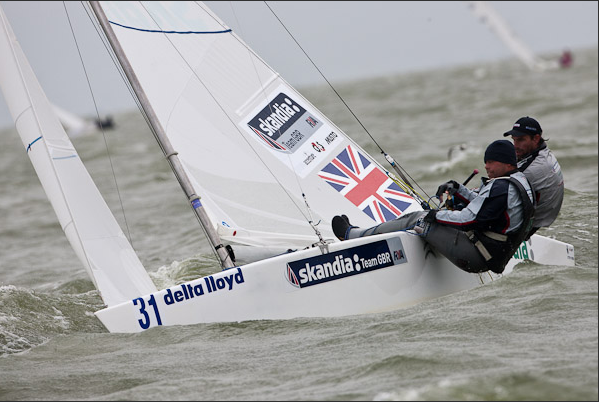
British Olympic Gold Medallists Percy and Simpson are coming to Dublin Bay next month. Photo: Delta Lloyd Regatta /Sander van der Borch
Beijing Gold Medalists, Britain's Ian Percy and Andrew Simpson, are confirmed for the presitgious Olympic class event that starts at the Royal St. George YC on September 2nd.
Ireland's other entry is Olympic triallists Max Treacy and Anthony Shanks from the host club.
The entries for the 2011 Star European Championships are:
| Skipper | Country | Sailing Number |
|---|---|---|
| Chatagny | CH | SUI 8075 |
| Niklaus Michel | CH | SUI 7829 |
| Alexander Schlonski | DE | GER 8426 |
| Maxwell Treacy | IE | IRL 8381 |
| Mateusz Kusznierewicz | PL | POL 8417 |
| DENIS KHASHINA | UA | UKR 8205 |
| Andrew Campbell | US | 8423 |
| Ante Razmilovic | UK | 8191 |
| Johannes Polgar | Germany | 8414 |
| Arthur Anosov | UKR | 8240 |
| Andrey Berezhnoy | Russia | 8359 |
| Barbara Beigel Vosbury | 7986 | |
| Fernando Echavarri | Spain | 8209 |
| Flemming Soerensen | Danish | 8225 |
| George Szabo | US | 8434 |
| Guillaume Florent | France | 8270 |
| Lev Shnyr | Russia | 8047 |
| MARIN LOVROVIC | Croatia | 8339 |
| Pavlo Bondar | UKR | 8119 |
| Tom Londrigan, Jr. | US | 8170 |
| Vasyl Gureyev | UKR | 8247 |
| Xavier ROHART | France | 8237 |
| Mate Arapov | 7287 | Croatia |
| Richard Clarke | 8361 | Canada |
| Stuart Hebb | 8427 | Canada |
| Tom Lofstedt | 8351 | Sweden |
| Diego Negri | 8266 | Italy |
| Peter O'Leary | 8418 | Ireland |
| Tibor Tenke | 8386 | Hungary |
‘Family Fun Day’ in Dun Laoghaire
Funds raised will go to the maritime museum which is housed in the former Mariners Church, which is run by the Maritime Institute of Ireland (M.I.I.). The museum is currently closed due to continued renovation and improvement works.
There will be a 'soft launch' or 'preview' of the maritime museum from October to mark the M.I.I.'s 70th anniversary. Next year the museum is due to be officially re-opened during the Easter. The M.I.I. welcomes new members, volunteers and donations to assist in the museum. For information visit www.mariner.ie
French Naval Vessel Escorts 'Figaro' Fleet to Dun Laoghaire
To celebrate the stopover of the four-stage 1,695 nautical mile (3,390 km) race, Dun Laoghaire Rathdown County Council, Dun Laoghaire Harbour Company and the National Yacht Club have joined forces to create the Festival des Bateaux (12-14 Aug).
A festival highlight will be a fireworks display which be held on Friday night at 10pm on the East Pier. In addition during the three-day festival programme includes live bands, street entertainment and a market on the Carlisle Pier. For more details and times of the free event go to www.dlrevents.ie
Visitors to the East Pier can take a closer view of the PSP Cormoran from the quayside where the 23 knot offshore patrol vessel (OPV) will be berthed. The Flamant class (OPV) entered service in 1997 after completion by Constructions Mécaniques de Normandie, Cherbourg, where the 477 tonnes vessel is based.
The 54m/177-ft vessel has two 12.7mm machine guns and is used for fishery monitoring, SAR and patrolling France's Exclusive Economic Zone out to 200 nautical miles / 370 km. In addition she is equipped with a high speed RIB-craft that can be deployed from an internal dock-well at the stern.
Veolia Environnement Clocks 15 Knots on Dublin Bay
The exotic French Trimaran Veolia Environnement was in Dalkey Sound this morning. The high speed craft circled around the island in modest north westerly winds and returned into Dublin Bay for what appeared to be a helicopter publicity-photoshoot. According to vessel tracking system she got up to 14.8 knots and no doubt more!
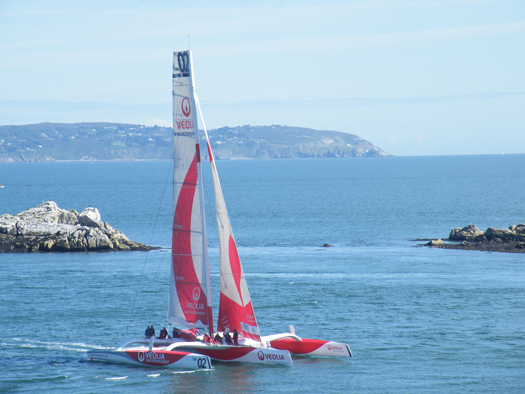
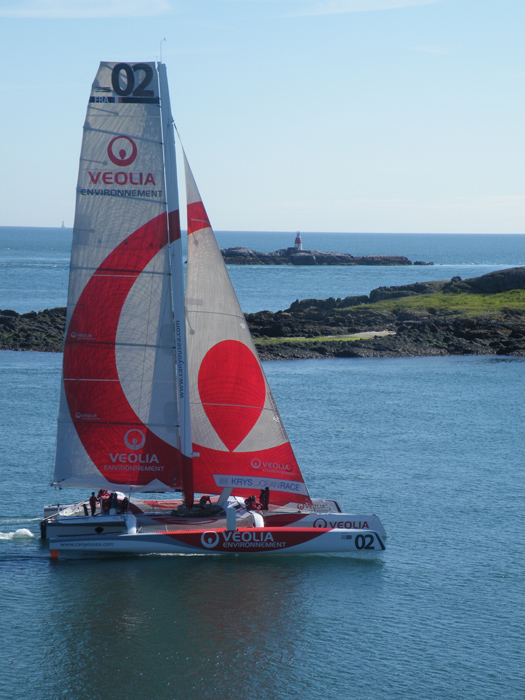
Veolia Environnement sails briskly down Dalkey Sound. Photo: Jehan Ashmore



























